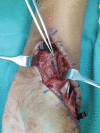Intra-arterial Foreign Body following Radial Artery Cannulation Requiring Microsurgical Removal: Case Report and Review of the Literature
- PMID: 33335371
- PMCID: PMC7735555
- DOI: 10.1055/s-0038-1676871
Intra-arterial Foreign Body following Radial Artery Cannulation Requiring Microsurgical Removal: Case Report and Review of the Literature
Abstract
We report the case of a pediatric patient who underwent intra-arterial exploration and removal of foreign body after an arterial catheter cannula inadvertently fractured during removal and a fragment remained within the radial artery. The fragment was visualized using fluoroscopy intraoperatively and was successfully removed from the common digital artery to the index finger where it had migrated. We present the case as a rare complication of an exceedingly common procedure with a timely response to avoid further complication.
Keywords: arterial line; complication; microvascular repair; radial artery cannulation.
Conflict of interest statement
Conflict of Interest None declared.
Figures
References
-
- Gardner R M. Direct arterial pressure monitoring. Curr Anaesth Crit Care. 1990;1(04):239–246.
-
- Nuttall G, Burckhardt J, Hadley A et al.Surgical and patient risk factors for severe arterial line complications in adults. Anesthesiology. 2016;124(03):590–597. - PubMed
-
- Durie M, Beckmann U, Gillies D M. Incidents relating to arterial cannulation as identified in 7,525 reports submitted to the Australian incident monitoring study (AIMS-ICU). Anaesth Intensive Care. 2002;30(01):60–65. - PubMed
-
- Luo C-F, Mao CC, Su B C, Yu H P. An iatrogenic complication of radial artery cannulation. Acta Anaesthesiol Taiwan. 2010;48(03):145–147. - PubMed
Publication types
LinkOut - more resources
Full Text Sources





